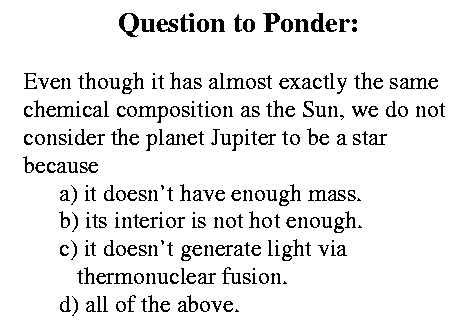|
|
Don't forget who you are You're a rock and roll star The Byrds, So You Want to be a Rock and Roll Star |
Assignments:Read Chapter 26, Section 7, and all of Chapter 27 (pp. 433-449) for Monday's classProblem Set #4 due Thursday 4 March
|

In Class:
-----------
review:
nuclear reactions
- involve only nuclei
- protons and neutrons
- electrons don't play much of a role
- key is to get stability
- not just any combination of p and n will work
- some combinations will be unstable
- might hold together for a little while
- how long an unstable arrangement will
last is often called a "half-life"
- time required for half of the
nuclei to fall apart (on average)
- unstable combinations will "decay"
- types of decay
- fission
- 92U235 + n --> 55Ce140 + 40Zr94 + n + n
(92p,143n + n --> 55p85n+ 40p54n + n + n)
- bop it with a neutron
- proton-neutron interchange (beta decay)
neutron can change to a proton
- 1H3 --> 2He3 + e-
(tritium to helium-3)
- for charge balance emits an e-
started neutral; have to end neutral
neutron falls apart into p+ and e-
proton can change to a neutron
- 7N13 --> 6C13 + e+
- for charge balance emits an e+ (positron)
started +; have to end +
proton falls apart into a neutron and positron
proton--> neutron process happens a lot in the Sun
- lots of protons around
- try to make nuclei with only protons
too many protons;
too much electronic repulsion
- they either fall apart
- or they convert protons to neutrons
until stable
-------------------
first step in Sun-like stars
In the hot core
T = 10-20 million K
size = 200,000 km (~25% of the Sun's radius)
mass = ~10-20% of the Sun's mass
1H1 + 1H1 --> 1H2 + e+ + neutrino
conversion to deuterium involves proton-->neutron conversion
positron doesn't get far
hit e- and annihilates --> lots of photon energy
photons are absorbed locally and HEAT THE CORE
neutrino is a very wierd particle
- doesn't really interact with anything
- cruises right out of the Sun, right through the Earth
through us, through basically everything
- the only bit that comes straight from the solar
core to us
- very hard to detect
- still can provide a window into the solar
interior
(you can read about it in your text)
OK, so we make deuterium, what next?
1H2 + 1H1 --> 2He3 + energy(i.e., photon)
no extra magic here
just stick another proton on
helium-3 is pretty stable
get the energy out in the form of a photon
quickly absorbed by nearby stuff
heats the core (which is, after all what we're
trying to do here)
So we can make lots of helium-3
2He3 + 2He3 --> 2He4 + 1H1 + 1H1
helium-4 is the "standard" helium; completely stable
liberates two protons; can participate in the next round
Net result: take 4 protons --> make 2He4
(actually take 6 p --> 2He4 + 2 extra protons, but the net result is above)
4 protons weigh 4 * 1.6726 x 10^-27 kg = 6.6904 x 10^-27 kg
2He4 weighs 6.6429 x 10^-27 kg
- we're missing a mass of 4.75 x 10^-29 kg
- where did this mass go?
- E = mc^2
- turned into energy
- mass and energy are more closely
related than you think
- can convert mass into energy and,
perhaps even more oddly,
can convert energy into mass
- can calculate the energy liberated by measuring
the "lost" mass
- E = mc^2 gives you the energy
- example:
for one PP reaction:
mass lost = 4.75 x 10^-29 kg
E = (4.75 x 10^-29 kg)(3 x 10^8 m/s)^2
= 4.28 x 10^-12 kg m^2 / s^
= 4.28 x 10^-12 Joules
- the mass "lost" is the source of energy for the Sun
- conversion from 4H's to He results in mass "loss"
- so in some odd way, the Sun really is burning up
The pp chain is the main process occurring in the Sun
|
![]()